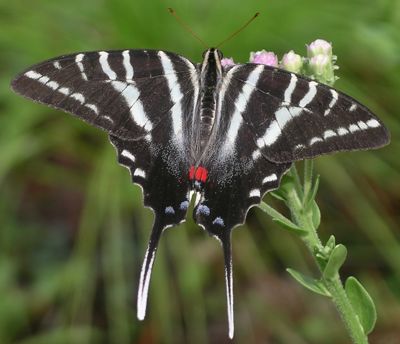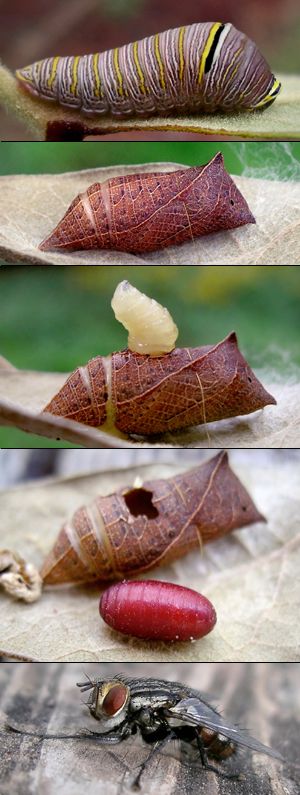
One of the more fascinating aspects of entomology is the amazing transformation that happens when an insect emerges from its pupa as an adult. This process is known as eclosion. When the insect has finished its time as a larva, during which it shed its outer covering several times to allow for growth, that last molt produces the pupa. This is the stage at which a maggot turns into a fly, a grub into a beetle, a hellgrammite into a dobsonfly, or a caterpillar into a butterfly. Although the process is well understood from a physiological standpoint, the result still seems almost magical.
Animal husbandry is not my strong suit, but sometimes the allure of watching complete metamorphosis unfold overshadows the effort necessary to successfully raise an immature insect to adulthood. The best subjects for this are, of course, the lepidoptera. The caterpillars are vegetarian so all that is needed is a supply of their host plant, which can easily be kept in the salad bin of a refrigerator. Cleaning up droppings is not too difficult - just dump them in the compost. Once the larvae pupate, they no longer require much care. The rewards at the end are seeing the fresh moth or butterfly test out its new wings, snapping a few photos of the gorgeous insect, and watching it fly away.
During a recent trip to central Florida, I encountered one of my favorite photography subjects: the Zebra Swallowtail. The range of this butterfly only extends as far west as east Texas, so finding the rare stray here in Austin is so unlikely that it hasn't happened for me yet. But during my trips to the Sunshine State, I do sometimes see and photograph this lovely species. This time, not only did I see several adults, but, for the first time, found caterpillars as well.
In spite of my reluctance to raise baby bugs, some of those caterpillars that I saw in Florida were just about ready to pupate, which meant they would need little care. The adult is so pretty that I thought it would be fun to photograph a very fresh one, and there is always the slight chance of obtaining one of my more elusive goals:  to watch a butterfly eclose. Notwithstanding all my observations and the time I spend watching and photographing insects, I've never had the privilege of witnessing any lepidopteran emerge from its pupa.
to watch a butterfly eclose. Notwithstanding all my observations and the time I spend watching and photographing insects, I've never had the privilege of witnessing any lepidopteran emerge from its pupa.
After finding a dozen or more, I chose a plump, large caterpillar and put it, along with a small branch of its host plant, in the usual sort of container I requisition for such things: one of those plastic food protectors for bakery items, like muffins or croissants. Within a few hours, the cooperative larva made the sort of fecal mess that signals it is about to pupate. Because pupation requires that the insect shed its entire skin, along with the alimentary canal, it must evacuate its gut before the process begins. After that, it will no longer eat and is simply waiting for metamorphosis to continue. My caterpillar spent this time huddled under a leaf.
Less than two days later, during my routine inspection of the larva, I found a chrysalis instead. I'd never seen the pupa of this species, so it was curious to note the elegant lines and finely mottled pattern that looked unlike that of any other swallowtail I'd seen. Keeping the clear plastic container in a conspicuous place, I then started checking it at least twice a day for any activity.
The wait wasn't long. Just three days later, my morning inspection revealed an odd sight. Coming out of the middle of the chrysalis was a plump white larva. It obviously wasn't a butterfly. It was a maggot. I thought I'd checked the caterpillar I had collected pretty carefully, but I'd obviously missed any sign that it was parasitized. As was now evident, earlier in its short life, a tachinid fly had laid an egg on its back. Once the egg hatched, the lepidopteran was doomed; the tiny parasitoid burrowed into the caterpillar's body and lived inside it, allowing its host to continue development only to the point of pupation. Then, after consuming all remaining tissue, the fly larva was ready to move on to its own pupa stage. As I watched the chubby maggot wiggle back and forth, working to squeeze out of the hole in the chrysalis that seemed barely big enough, I was only a little disappointed at the lack of a different outcome. I had, after all, seen other adult Zebra Swallowtails, but now I could observe an additional species.
A few hours later, the fly had formed its puparium: an oval, reddish brown case with a hard covering devoid of any detail. The little puparium rattled and rolled around every time I lifted the container to look at it. It seemed normal, so it was just a matter of time before the adult would emerge. Once again, I had the slight chance of seeing a metamorphosis event occur if I happened to look when the fly was eclosing. Tachinid flies break out of their puparium by everting a special sac at the front of their face called a ptilinum. This structure works pretty much like an airbag on a car, but it doesn't offer protection, it pushes its way through the hard outer covering, cracking it open so the fly can emerge. Once the fly is out, the ptilinum is withdrawn back into the head and is not seen again.
Well, I missed this eclosion episode too: less than two weeks later, I found an adult fly buzzing around in the container. Since the fly was so active, I chilled it in the refrigerator for awhile to make sure it would not escape before I took some photos. It cooperated nicely and I was able to take close up pictures while it remained stationary. Unfortunately, there are a huge number of different tachinid flies, and many of them look quite similar, so I haven't figured out the identity of this one. That is yet another future project on my long list of mysteries to be solved.
If the characters in this little tale had been animals more closely related to humans, the outcome might have seemed at least negative, if not downright gruesome. But the matter of fact way that nature proceeds, with billions of tiny creatures living their little dramas, inextricably entwined and mostly unseen by us, is more often cause for curiosity, reflection and wonder.